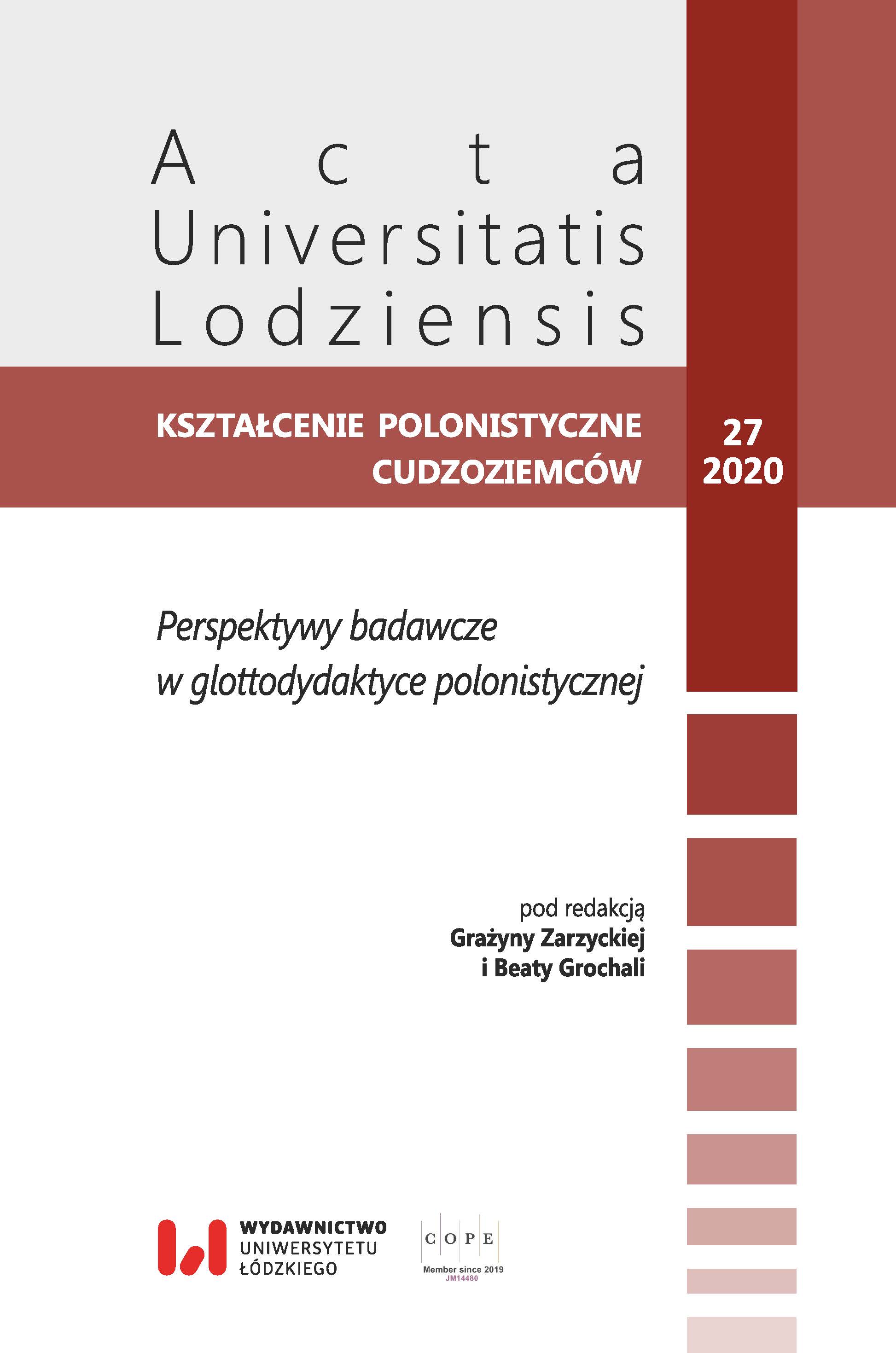Kształcenie kompetencji translatorycznej rozważania teoretyczne i metodologiczne
DOI:
https://doi.org/10.18778/0860-6587.27.23Słowa kluczowe:
kompetencja translatoryczna, metodyka nauczania języków obcych, przekładoznawstwo, dydaktyka przekładu, nauczanie języka polskiego jako obcego, programy kształcenia tłumaczyAbstrakt
Celem niniejszego artykułu jest przedstawienie wybranych definicji i koncepcji kompetencji translatorycznej, głównie w oparciu o prace anglojęzyczne. Autor wychodzi od najwcześniejszych prac generatywistów i pokrótce charakteryzuje początki prac nad teoretycznymi podwalinami kompetencji translatorycznej. W dalszej części artykułu zostaną przedstawione najważniejsze zmiany i nurty w badaniach nad kompetencją – przede wszystkim osiągnięcia hiszpańskiej grupy badawczej PACTE oraz tzw. definicja minimalistyczna Pyma. W końcowej części artykułu autor postara się udzielić odpowiedzi na pytanie, jakie są glottodydaktyczne implikacje wyłaniające się z różnych definicji kompetencji translatorycznej. W oparciu o teorię „kompetencji przedtłumaczeniowej” (ang. pretranslation competence) w ujęciu Presas (2000), spróbuje wskazać różnice pomiędzy procesem kształcenia językowego na filologiach a na studiach tłumaczeniowych.
Bibliografia
Ballard M., 1984, La traduction relève-t-elle d’un pédagogie?, w: M. Ballard (red.) La traduction: de la théorie à la pratique, Lille.
Google Scholar
Bednarska K., 2017, Słownictwo specjalistyczne w nauczaniu języka słoweńskiego jako obcego na kierunku lingwistyka dla biznesu [online], http://repozytorium.uni.lodz.pl:8080/xmlui/handle/11089/23546 [10.06.2020]
Google Scholar
DOI: https://doi.org/10.18778/0860-6587.24.15
Biel Ł., 2011, Professional Realism in the Legal Translation Classroom, “Meta”, t. 56(1), s. 162–178. https://doi.org/10.7202/1003515ar
Google Scholar
DOI: https://doi.org/10.7202/1003515ar
Bloomfield L., 1933, Language, Chicago.
Google Scholar
Caminade M., Pym A., 1998, Translator-training institutions, w: M. Baker (red.), Routledge Encyclopedia of Translation Studies, London, s. 280–285.
Google Scholar
ESOKJ – Europejski system opisu kształcenia językowego: uczenie się, nauczanie, ocenianie, 2003, Warszawa.
Google Scholar
Ervin S., Osgood Ch.E., 1954, Second Language Learning and Bilingualism, w: Ch.E. Osgood, T.A. Sebeok (red.), Psycholinguistics, Bloomington, s. 139–146.
Google Scholar
González-Davies M., Scott-Tennent Ch., 2005, A problem-solving and student-centered approach to the translation of cultural references, “Meta”, t. 50(1), s. 160–179. https://doi.org/10.7202/010666ar
Google Scholar
DOI: https://doi.org/10.7202/010666ar
Gouadec D., 2007, Translation as a Profession, Amsterdam.
Google Scholar
DOI: https://doi.org/10.1075/btl.73
Harris B., 1977, The Importance of Natural Translation, “Working Papers in Bilingualism”, t. 12, s. 96–114.
Google Scholar
Harris B., Sherwood B., 1978, Translating as an Innate Skill, w: D. Gerver, H. Wallace Sinaiko (red.), Language, Interpretation and Communication, New York & London, s. 155–170.
Google Scholar
DOI: https://doi.org/10.1007/978-1-4615-9077-4_15
Janowska I., 2011, Podejście zadaniowe do nauczania i uczenia się języków obcych. Na przykładzie języka polskiego, Kraków.
Google Scholar
Janowska I., 2017, Mediacja i działania mediacyjne w dydaktyce języków obcych, „Języki Obce w Szkole”, nr. 3, s. 80–86, http://jows.pl/sites/default/files/jows-3-2017_iwonajanowska.pdf [31.08.2020]
Google Scholar
Kelly D., 2005, A Handbook for Translator Trainers. A Guide to Reflective Practice, Manchester.
Google Scholar
Kiraly D., 2005, Project-Based Learning: a Case for Situated Translation, “Meta”, t. 50(4), s. 1098–1111. https://doi.org/10.7202/012063ar
Google Scholar
DOI: https://doi.org/10.7202/012063ar
Koller W., 1979, Einführung in die Übersetzungswissenschaft, Heidelberg.
Google Scholar
Krings H.P., 1986, Was in den Köpfen von Übersetzern vorgeht, Tübingen.
Google Scholar
Kussmaul P., 1995, Training the Translator, Amsterdam & Philadelphia.
Google Scholar
DOI: https://doi.org/10.1075/btl.10
Lipińska E., Seretny A. (red.), 2016, Tłumaczenie dydaktyczne w nowoczesnym kształceniu językowym. Monografia zbiorowa, Kraków.
Google Scholar
Lörscher W., 1991, Translation Performance, Translation Process, and Translation Strategies, Tubingen.
Google Scholar
Orozco M., Hurtado Albir A., 2002, Measuring Translation Competence Acquisition, “Meta”, t. 47 (3), s. 375–402. https://doi.org/10.7202/008022ar
Google Scholar
DOI: https://doi.org/10.7202/008022ar
PACTE, 2000, Acquiring Translation Competence: Hypotheses and methodological problems in a research project, w: A. Beeby, D. Ensinger, M. Presas (red.), Investigating Translation, Amsterdam, s. 99–106. https://doi.org/10.1075/btl.32
Google Scholar
DOI: https://doi.org/10.1075/btl.32.13pac
PACTE 2003, Building a translation competence model, w: F. Alves (red.), Triangulating translation: perspectives in process oriented research, Amsterdam, s. 43–66. https://doi.org/10.1075/btl.45
Google Scholar
DOI: https://doi.org/10.1075/btl.45.06pac
Presas M., 1998, Los components de la competencia pretraductora en el marco del diseño curricular, w: I. García Izquierdo, J.M. Verdegal (red.), Los estudios de traducción: un reto didáctico, Castelló de la Plana, s. 131–134.
Google Scholar
Presas M., 2000, Bilingual Competence and Translation Competence, w: Ch. Schäffner, B. Adab (red.), Developing Translation Competence, Amsterdam, s. 19–31. https://doi.org/10.1075/btl.38
Google Scholar
DOI: https://doi.org/10.1075/btl.38.04pre
Pym A., 2003, Redefining Translation Competence in an Electronic Age. In Defence of a Minimalist Approach, “Meta”, t. 48(4), s. 481–497. https://doi.org/10.7202/008533ar
Google Scholar
DOI: https://doi.org/10.7202/008533ar
Pym A., 2008, Professional corpora: Teaching strategies for work with online documentation, translation memories, and content management, “Chinese Translators’ Journal”, t. 29(2), s. 41–45, https://usuaris.tinet.cat/apym/on-line/translation/2008_professional_corpora.pdf [10.06.2020]
Google Scholar
Pym A., 2013, Translation Skill-Sets in a Machine-Translation Age, “Meta” t. 58(3), s. 487–503. https://doi.org/10.7202/1025047ar
Google Scholar
DOI: https://doi.org/10.7202/1025047ar
Schäffner Ch., 2005, Preparing students of translation for the real world: Needs, methods, constraints, w: J. Peeters, (red.), On the Relationships Between Translation Theory and Translation Practice, Frankfurt, s. 237–248.
Google Scholar
Sim R., 2000, A Training Strategy for Translation Studies, w: Ch. Schäffner, B. Adab (red.), Developing Translation Competence, Amsterdam, s. 171–182. https://doi.org/10.1075/btl.38.16sim
Google Scholar
DOI: https://doi.org/10.1075/btl.38.16sim
Snell-Hornby M., 1994, New Translation Departments – Challenges of the Future, w: M. Snell--Hornby, F. Pöchhacker, K. Kaindl (red.), Translation Studies, An Interdiscipline, Amsterdam & Philadelphia, s. 431–434.
Google Scholar
DOI: https://doi.org/10.1075/btl.2.50mot
Szafraniec K., 2012, Metoda gramatyczno-tłumaczeniowa oraz elementy przekładu w glottodydaktyce polonistycznej, „Acta Universitatis Lodziensis. Kształcenie Polonistyczne Cudzoziemców”, t. 19, G. Zarzycka (red.), s. 93–103.
Google Scholar
Weinreich U., 1968, Languages in Contact: Findings and Problems, Mouton.
Google Scholar
Wills W., 1976, Perspectives and limitations of a didactic framework for the teaching of translation, w: R.W. Brislin, (red.), Translation, New York, s. 117–137.
Google Scholar
Wilss W., 1982, The science of translation. Problems and Methods, Tübingen.
Google Scholar
Pobrania
Opublikowane
Jak cytować
Numer
Dział
Licencja

Utwór dostępny jest na licencji Creative Commons Uznanie autorstwa – Użycie niekomercyjne – Bez utworów zależnych 4.0 Międzynarodowe.










